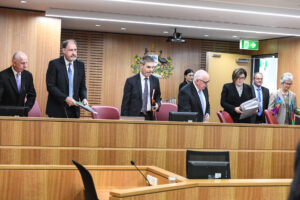The ending of mandatory Covid isolation periods has also ended disaster payments for workers who don’t have access to sick leave. It’s time we faced up to the fact that the industrial relations rules have been creating the wrong kinds of work.
That’s the bad news. The good news is we can change them if we want to.
Forcing workers to choose between staying home with Covid and getting paid is not a real choice. Rent, mortgage payments and bills don’t disappear because you’re sick.
The government understood this when the pandemic hit, which is why the disaster payments were introduced. These disaster payments were government-funded Covid leave for workers who didn’t have access to paid leave, but had to stay away from work because they had Covid or Covid-like symptoms, had been exposed to someone with Covid, or had to care for someone with the disease.
But just because compulsory isolation has been scrapped doesn’t mean that going to work sick is a good idea.
The solution is for all employers to provide paid sick leave, to all their staff: whether permanent, casual, contractors, or “gig” workers.
Right now more than one-third of employed Australians do not receive pay when they are off sick. That creates a powerful, perverse incentive for them to go to work anyway – risking their own health, their colleagues’ health and the whole community’s (especially during a pandemic).
Workers attending their jobs while sick or exposed to Covid has been a major problem during the pandemic. Australia Institute research shows that about one in five respondents (and a higher proportion of young workers) have attended work with potential Covid symptoms since the pandemic started. This poses an enormous risk to their health, and public health – and it is clearly exacerbated by the inadequacy of current sick pay provisions.
Sometimes a sudden shock can highlight just how far we have let things drift.
The ending of disaster payments, and the idea that sick workers may be financially compelled to go to work, is a moment to confront the drift we have experienced over the past few decades towards precarious work. The traditional standard employment relationship, in which workers enjoyed permanent work with normal entitlements (such as paid time off, workers compensation, superannuation, and a minimum wage), has been steadily eroded by the expansion of precarious work in many different forms.
Today only half of employed Australians have a permanent full-time job with normal entitlements. The other half experience one or more dimensions of precarious work.
This has happened largely under our noses, like the proverbial frog in the pot slowly being boiled alive. But the ending of disaster payments provides us with a moment to jump out of the water.
Victoria has already identified the gaps in our existing sick leave provisions, and has introduced a sick pay guarantee that provides eligible casual and contract workers with sick pay. This is a great first step, but this issue is more easily fixed at the federal level, since the federal government has the most influence over employment laws.
The Victorian system also depends on the government paying for the sick leave. For more than half a century it has been standard in Australia for business to pay for leave entitlements. It is not radical to expect them to pay for sick leave, as a normal cost of employing people to perform the business’s work.
The increase in precarious work has had other consequences. Those in precarious forms of work have less bargaining power which is helping keep wages low even at a time of historically low unemployment.
Federal Treasury and the Reserve Bank are constantly amazed that wages seem unable to grow. We know this because they keep getting their forecasts of wages growth so wrong. We have an unemployment rate of 3.5%, but still no wages growth. Something is clearly broken and part of this is precarious work.
So what can the government do? They can change the rules to restrict precarious forms of work. They should be the exception, not the norm. This involves properly defining causal and other forms of work.
Those in precarious work need to be able to convert to permanent if they want to. There should not be a situation where workers spend years in precarious forms of work with no hope of permanent employment.
The government also needs to look at changing the working conditions for causals to force employers to provide paid sick leave. Paid sick leave should be a right of all working people regardless of the conditions of their employment.
While precarious work might be good for the short-term profits of some businesses, the pandemic has highlighted that it is not good for society as a whole. At a time when company profits are high and the share of national income going to workers is at an all-time low, we need to change the system.
The pandemic is a wake-up call that shows all workers need access to paid sick leave.
Between the Lines Newsletter
The biggest stories and the best analysis from the team at the Australia Institute, delivered to your inbox every fortnight.
You might also like
If business groups had their way, workers on the minimum wage would now be $160 a week worse off
Had the Fair Work Commission taken the advice of business groups, Australia lowest paid would now earn $160 less a week.
The continuing irrelevance of minimum wages to future inflation
Minimum and award wages should grow by 5 to 9 per cent this year
A fair go for temporary workers from the Pacific
On a whistlestop tour of Fiji, Tonga, and Vanuatu in May, Foreign Minister Penny Wong wanted to focus on climate change, security, and aid funding.



